Difference between revisions of "Thiarian B-Class destroyers"
Acelanceloet (talk | contribs) (Created page with "In 1955, most restrictions on Thiaria’s military were lifted. Thiaria’s destroyer force at that time consisted of four T-class ships and a mix of older N- and P-class unit...") |
(No difference)
|
Revision as of 21:06, 17 September 2018
In 1955, most restrictions on Thiaria’s military were lifted. Thiaria’s destroyer force at that time consisted of four T-class ships and a mix of older N- and P-class units; eight A-class destroyers which had been begun during the war were in the process of being completed to a modest ASW design since 1951. They were completed between 1955 and 1958 and replaced the pre-war destroyers. The T’s, which had seen intense war service and just about run out of growth potential – especially for radars and electronics – would also need replacement at short notice. Preliminary studies based upon a 1943 design for a 3.500-ton destroyer leader had already been undertaken from 1953, and the final design for the 1955 destroyer was already approved several weeks before the Americans gave green light to resume warship construction. Particulars were the following:
Displacement: 3.850 ts standard, 5.100 ts full load LOA: 146,50 m Beam: 15,20 m Draught: 4,58 m mean (without sonar dome), 5,64m deep load Machinery: Two-shaft TDA steam turbines, four Llanhaudh 1.000psi boilers, 80.000 SHP Speed: 32,5 knots Range: 6.000 nm @ 20 kts Crew: 320
Although based upon a development of a WW2 design, the new type included many novel features: They were the first Thiarian destroyers with five-bladed screws and retractable fin stabilizers, and the first to follow the contemporary fashion of using aluminium for much of the superstructure. They were designed with ample volume reserves for additional electronics and had a very modern appearance due to their futuristic bridge structure and streamlined funnels. Most importantly, with the numerical size of Thiaria’s navy severely curtailed, these ships were to receive a revolutionary new type of main armament: SAMs. At that time, the only (more or less) operational SAM system available on the free market was the Swiss Oerlikon RSA; the Thiarians had acquired several launchers and missiles for testing purposes in 1953/4 and (at first secretly) developed a much more robust navalized launch and guidance system for these missiles. Primitive as they were – they were liquid-fueled and could not be kept at extended readiness, their beam-riding guidance only allowed the engagement of markedly subsonic targets at medium altitude, and they needed to be reloaded using trolleys and a crane, as the proposed 25-round vertical drum magazine was too large for any destroyer-sized ship – they nevertheless extended the air defence range of any ship carrying them to 12 nautical miles, quite beyond the range of any operational airborne antiship weapon of that age. Apart from the missile system, armament and sensor suite of the design made full use of the ship’s generous size and was complete and well balanced:
Armament: Two Mk42 127mm gun mounts, two twin Mk33 76mm gun mounts, four triple 400mm ASW torpedo tubes, two hedgehogs, one twin launcher for a total of 24 RSA missiles. Sensors: SPS-6 long range air search, SPS-8 height finder, SPS-10 surface search, SPG-53 GFCS, Mk.56 GFCS, WLR-1/3 ECM, ULQ-6 ECM, A16T-1 bow sonar
Four ships were ordered in 1955; two were laid down early in 1956 (Abernenui Naval Yard and CTS), two early in 1957 (Nuatearman Naval Yard and CSCA). Following Thiarian naming conventions, they received adjectives beginning with a B as names, in order: Bithdhilis (Constant in Loyalty), Broduil (Proud), Buach (Victorious) and Beomhar (Vivacious). Construction was given maximum priority and proceeded swiftly; all four were completed in under three years. As usual, CSCA built fastest and delivered Buach after 25 months. Trials were somewhat rushed, as if the Thiarians wanted to get as many of these ships into service before the 1950s were over for some irrational reason; Bithdhilis and Buach were commissioned together on September 1st, 1959, with Broduil following on December 15th that year and Beomhar on June 20th, 1960. The first two units of the class narrowly beat the US Coontz-class into service; this achievement made these Thiarian ships the first operational missile destroyers worldwide.
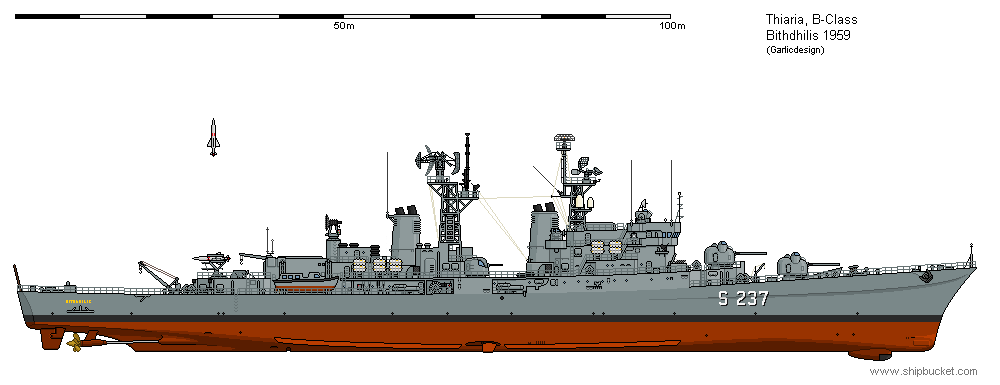
By the time these ships were complete, a substantially improved version of the RSA missile called RSC had become available, complete with an improved guidance system and launcher. Beomhar was already commissioned with this system and served as testbed; Bithdhilis was later retrofitted. The missile had longer range (20 nm), was faster (Mach 2,8) and a lot more maneuverable, but retained liquid fuel and beam riding guidance.
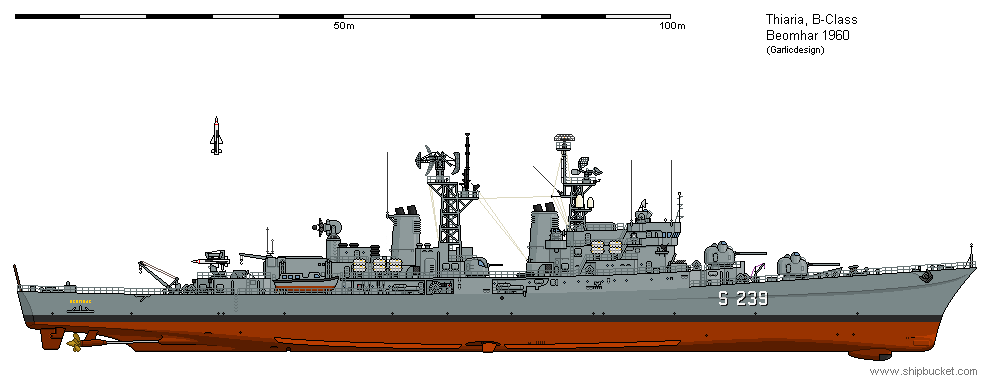
Although the advantages of the RSC missile over the RSA were substantial, the whole concept had little growth potential; by the early 1960s, potential enemies had supersonic jets on their aircraft carriers, against which missiles with beam-riding guidance were of little use. Consequently, Buach and Broduil were not refitted with the RSC. Fortunately for the Thiarians, the new Kennedy administration in the USA abandoned the previous government’s reluctance to to deliver high-end weaponry to Thiaria, and in 1963, the Thiarians placed an order for four Mk13 Tartar missile systems complete with launchers and SPS-26 3D radars. Unusually, modified SPG-55s were employed for guidance rather than the usual SPG-51s, in order to ensure commonality with the Terrier guidance systems installed in two Thiarian cruisers at that time. The planned Tartar refit would also have included removal of the by then rather useless hedgehogs and the installation of new US-sourced SQS-23 bow sonars.
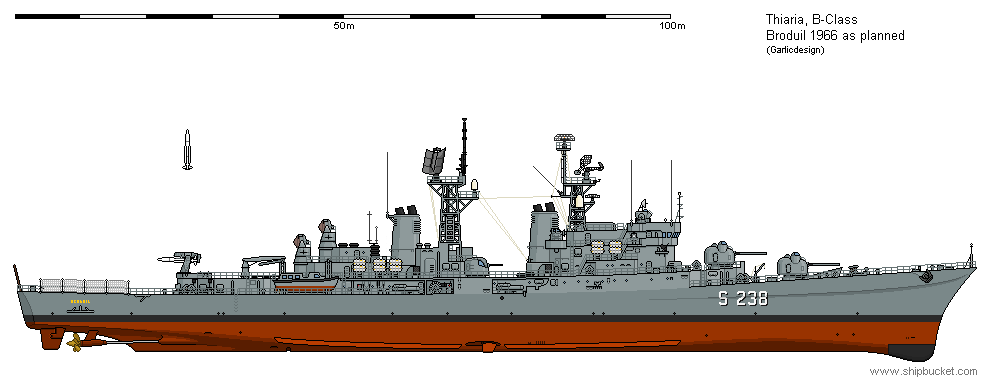
These plans however came to naught. Thiaria descended into civil unrest in 1965 after CIA attempts to influence elections, and the 1966 repeat elections yielded a far-left government which openly leaned towards the east block. Only one of the Tartar systems was ever delivered, and that one was installed on a cruiser instead of a B-class destroyer. The Thiarians decided to phase out the RSA anyway and convert Buach and Broduil to ASW destroyers. They purchased Malafon standoff ASW weapons and towed array sonars in France, which was still willing to supply weapons to Thiaria after its slide to the left. The whole aft superstructure was replaced with a helipad and a spacious hangar above the Malafon magazine. TACAN and a primitive Satcom antenna were installed, a Thiarian-designed B23E-1 air-/surface search radar replaced the SPS-10, and an additional B22L-1 navigation radar was fitted. The hull sonar was replaced by a bow-mounted Thiarian A20T-1 set. Two Alouette II helicopters (which could carry a single 400mm ASW torpedo each) were embarked as a stop-gap solution. Conversion of Broduil was complete in 1969, Buach followed in 1970.

After the 1970 elections consolidated the far left government, Thiarian military co-operation with the Soviets increased, and it was decided to first refit Bithdhilis and Beomhar to a similar standard, then further refitting all four with Soviet and additional domestic equipment. The 76mm guns and their directors were landed and replaced with two retractable twin launchers for Osa-M (SA-N-4) missiles including new directors and a Thiarian B31T-1 target indication radar forward; the navigation radar was moved to the roof of the bridge. Two modified AK-230 turrets with radar guidance, which were fitted with new Thiarian Hispano-Suiza HS.804 20mm/80 cannon instead of the soviet 23mm originals, were installed aft for close defence. Two RBU-6000 ASW rocket launchers were fitted forward where the hedgehogs used to be. The SPS-6 was replaced by the new, large and powerful Thiarian B28A-2 very long range air search radar, which impressed the Soviets very much, and Soviet high-powered jamming gear was installed. Bithdhilis’ and Beomhar’s conversions were completed in 1974, the other two followed in the year after. By that time, the first specimens of the new Thiarian Muiscit helicopter (armed with two 400mm torpedoes or depth charges or unguided rockets and fitted with FLIR and a dipping sonar) were available; the type was tested on Bithdhilis in 1974, and by 1976, all four embarked two of these helicopters each.

Thiaria’s far left government was weakened in the 1974 elections, and Thiaria’s refusal to join the oil embargo against the west in this year soured relations to the Soviets. Between 1974 and 1978, Thiaria had three governments, and by 1977, the Soviet alliance was de facto dead. Although no spare parts for Soviet systems were delivered after that year, the Thiarians built unlicensed copies of them and continued to use Soviet equipment. Further modernizations of the B-class were undertaken in 1980 through 1982. They landed half their 400mm torpedo tubes in favour of four Exocet missiles in firing canisters mounted amidships, firing straight athwartships. The air- and combined search radars were upgraded to make them more jam-proof, and a modern SATCOM was installed, as was a decoy launcher. The 127mm guns were relined to 130mm and supplied with new extra long-range ammunition. In this shape, Bithdhilis and Beomhar shadowed the British fleet during Britain’s war with Argentina after Patagonia’s unilateral declaration of full independence in 1982 and Argentina’s subsequent invasion. Beomhar was fitted with the prototype of a new integrated commo mast shortly before that operation.
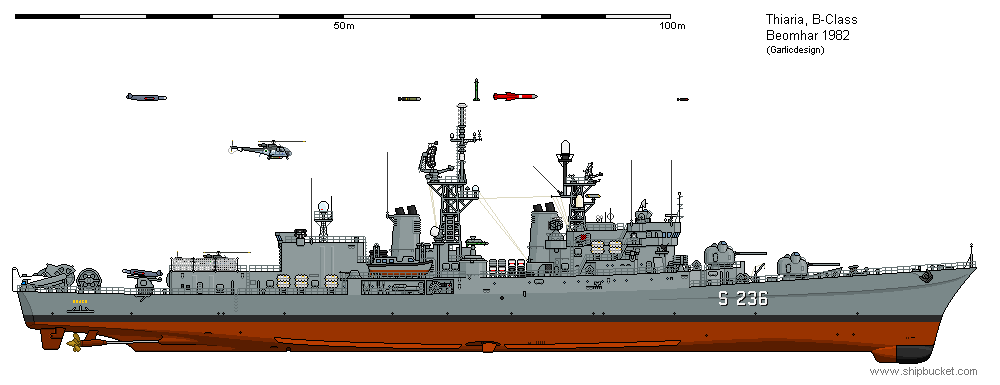
By the mid-1980s, these ships were quite worn; their construction had been very rushed and they aged quickly. All received the new commo mast in 1984/5, but after that, no further modifications were undertaken. In the second half of the 1980s, several of these ships were used to trial new equipments to be installed in their own replacements of the new C-class, which became available between 1988 and 1993. Broduil in 1988 embarked the new fully automatic 130mm/60 compact gun turret, the new B33G-1 domed multipurpose gun- and missile fire control radar system and the new B34A-1 very long range phased array 3D-radar.
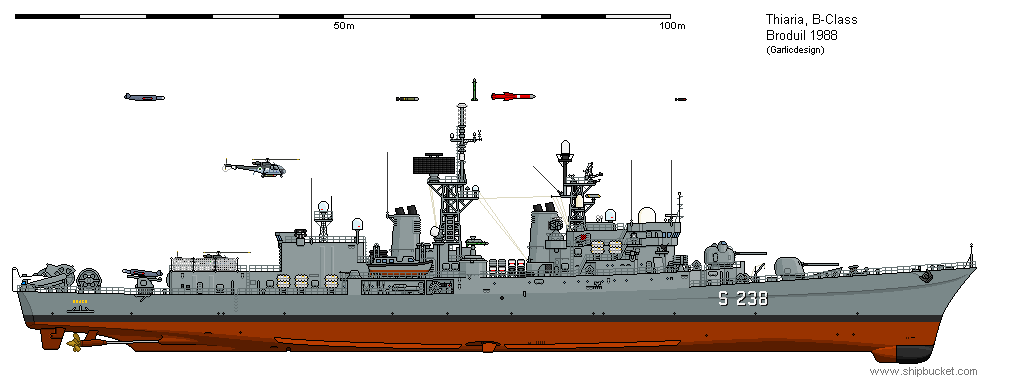
The B-class was decommissioned from 1989 through 1993 after an average of 30 years in service; all four units were scrapped by 1998.